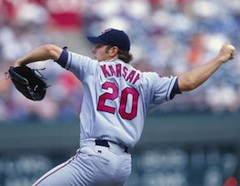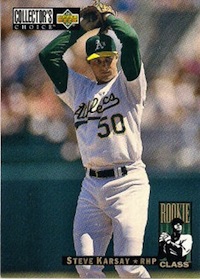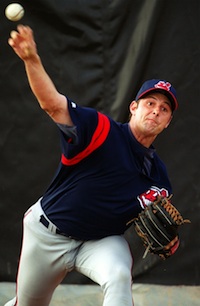 Indians Archive
Indians Archive  Opposite Field #7: Tribe/A's & The Ballad of Steve Karsay
Opposite Field #7: Tribe/A's & The Ballad of Steve Karsay
 It’s fairly customary in baseball parlance to hear about “the sweetest swings” in the game or the “slickest gloves.” But for whatever reason, the pitchers with the “smoothest deliveries” don’t seem to get quite the same recognition. If they did, former Indians right-hander Steve Karsay would have his rightful place in the pantheon of pitching mechanics. Because— and I say this objectively and without hyperbole—Steve Karsay was the most fundamentally sound pitcher of all-time.
It’s fairly customary in baseball parlance to hear about “the sweetest swings” in the game or the “slickest gloves.” But for whatever reason, the pitchers with the “smoothest deliveries” don’t seem to get quite the same recognition. If they did, former Indians right-hander Steve Karsay would have his rightful place in the pantheon of pitching mechanics. Because— and I say this objectively and without hyperbole—Steve Karsay was the most fundamentally sound pitcher of all-time.
Now bear with me here a second. I admit that weird, random thoughts like this can enter your mind pretty easily in the wee wee hours of a Tribe road game in Oakland-- sleepily assessing the inconsistent release point of Ubaldo Jimenez or the shot-put motion of Tony Sipp. Fact is, there are roughly 4.237 ways to throw a baseball, and as long as you get results, it’s doesn’t really matter which method you adopt. This explains the lengthy career of a Dave Burba, for example-- a pitcher best appreciated on the radio. Still, there is something to be said for real style and grace in the art of pitching. On its own, it will never trump statistics. But like the lumberjack hacks of an overmatched Russell Branyan, there’s poetry in one’s motion that no boxscore can match.
Of course, thanks to Major League Baseball’s stubborn, self-defeating refusal to open up its video archive, there’s not actually any easily accessible footage of Steve Karsay at our disposal. And since it’s been over a decade since he last toed the rubber for the Tribe, the actual choreography of his windup and delivery has become shrouded in legend. Did he really bring his glove completely over his head, or was it more at shoulder level? Did he throw perfectly overhand, or more at a three-quarters point? Obviously, all of us ponder these questions on a regular basis (right?!). But only Steve himself knows for sure anymore, and he’s busy with his new gig as the pitching instructor for the Indians’ Arizona Rookie League team (good hire, Shapiro).
Anyway, with the Indians visiting the cavernous Oakland Coliseum for the weekend, it’s hard for those with photographic memories not to recall the 1999 season—the last of the Tribe’s ‘90s juggernauts—when Cleveland swept four straight from the A’s on the road in late April; putting them well on their way to another Central Division title. The winner of the first game of that series was, naturally, Steve Karsay—a former A’s prospect still working his way back from arm surgery with the Tribe.
 A first round draft pick of the Blue Jays in 1990, the hard throwing Karsay was traded to Oakland basically straight-up for a still dangerous Rickey Henderson at the trade deadline in 1993. Henderson and the Jays went on to win the World Series, and Karsay looked promising in a late-season callup with Oakland, going 3-3 with a 4.04 ERA. Heading into the ’94 season, Steve was rated the #12 prospect in the game by Baseball America. Then the wheels came off.
A first round draft pick of the Blue Jays in 1990, the hard throwing Karsay was traded to Oakland basically straight-up for a still dangerous Rickey Henderson at the trade deadline in 1993. Henderson and the Jays went on to win the World Series, and Karsay looked promising in a late-season callup with Oakland, going 3-3 with a 4.04 ERA. Heading into the ’94 season, Steve was rated the #12 prospect in the game by Baseball America. Then the wheels came off.
Despite his seemingly effortless throwing style, Karsay had to undergo Tommy John surgery, missing a good chunk of the ’94 season and all of 1995. And when he returned in ’96, he never advanced beyond an extended rehab stint with Oakland’s Single-A squad in Modesto. When he finally rejoined the Athletics in 1997, the 25 year-old Karsay still had the moves right, but the results did not follow. He started 24 games, going 3-12 with a 5.77 ERA and 1.61 WHIP. And at season’s end, he was traded to Cleveland—not for a future Hall of Famer this time—but for a fat and useless Mike Fetters.
A once promising career easily could have ended right there, but John Hart saw something left in the good-natured kid from Flushing, New York. Chances are, it was those impeccable mechanics.
Now, when you’re talking about mechanics with Karsay, there wasn’t actually anything mechanical about it. There was zero rigidity in his approach—no quirks, no herky-jerky hesitations, and no wasted movement. The whole process had the cadence of a ballet dance—stride, rotate, glide, fire. Out of the stretch? Just glide and fire. He worked this way, with seemingly minimal effort and consistent rhythm. And when the Indians converted him into a reliever to ease the wear on his arm, it looked like he’d finally found the perfect stage for his talents.
In that 1999 season, Karsay entered August with an 8-1 record and 2.73 ERA out of the Tribe pen, working as one of closer Mike’s Jackson’s most reliable setup men. With a hole to fill in the starting rotation, though, Mike Hargrove decided to take a gamble towards the end of the year. Karsay would be converted back into a starter, to see if his newfound dominance could translate back to his original role. At first, it looked like a genius move.
In his first two starts, Karsay shut down Baltimore and Texas, allowing just 1 run over 10 innings, and picking up two more wins. He was now 10-1 with a 2.41 ERA and gaining national attention for his impressive comeback story. His next start would be August 24… back in Oakland.
Facing a solid A’s lineup, Steve cruised through the first two innings, with the Indians up 5-0. The team that had left him for dead was now paying the price. Steve Karsay, the much-ballyhooed prospect, had finally arrived.
Then the third inning happened. After retiring the first hitter, Karsay gave up a homer to A.J. Hinch. He then loaded the bases on a walk, a single, and a hit-by-pitch, and served up a Grand Slam to John Jaha. The game was suddenly tied. Steve finished the inning, but informed the Indians training staff that he felt some soreness in his wing. His day was over, and after an exam, he was back on the DL, never to start another game in his career.
 Of course, Karsay fans know the story doesn’t end there by any means. The Comeback Kid returned to the bullpen in 2000 and impressively won the Indians closer job, saving 20 games that season (though he was forced to jettison his immaculate wind-up in the process). The following June, however, the Karsay era in Cleveland was over, as he was shipped to Atlanta in the infamous deal for John Rocker. For Steve, the rollercoaster just kept on rolling.
Of course, Karsay fans know the story doesn’t end there by any means. The Comeback Kid returned to the bullpen in 2000 and impressively won the Indians closer job, saving 20 games that season (though he was forced to jettison his immaculate wind-up in the process). The following June, however, the Karsay era in Cleveland was over, as he was shipped to Atlanta in the infamous deal for John Rocker. For Steve, the rollercoaster just kept on rolling.
In 2002, he saved 12 games as a key bullpen arm for his hometown Yankees, then missed another entire season due to injury in 2003.
Somehow, Karsay fought his way back time and again, even signing a Minor League deal with the Indians again before rounding out his career back where it started, in Oakland. On June 17, 2006, Karsay tossed two shutout innings against the Angels at Oakland Coliseum to earn a win. The next day, he announced his retirement. The daily strain on his surgically repaired arm wasn’t worth it anymore.
The man with the flawless delivery ended his career with a record of just 32-39 with a 4.01 ERA. Statistically, he would only ever be a footnote. And logically, his approach to pitching only seemed to promise a lot of risk factors. But then again, for a human being, there really isn’t any such thing as “mechanically sound” when you’re talking about snapping your arm in a downward motion repeatedly a couple hundred times a week. We’re just fortunate as Tribe fans that we got to see someone who abused their arm as gracefully as Steve Karsay did.
- NBA Announces 2013-2014 Schedule
- Browns Ink Sharknado
- Sharknado A No-Show For Rookie Camp
- Trent Richardson Out Until Training Camp
- Browns Sign Brandon Jackson
- Carrasco Suspended Eight Games
- Browns Add to Wide Receiver Depth with David Nelson
- Browns Need to Learn from Past Draft Mistakes
- Browns Release Chris Gocong and Usama Young
- Browns Missing on Grimes Disappointing, But Not The End
The TCF Forums
- Chris Grant's first 3 drafts
Kingpin74 (Tuesday, January 21 2014 10:13 AM) - The 2014 Offseason Thread
googleeph2 (Tuesday, January 21 2014 9:36 AM) - 2015 Recruiting
furls (Tuesday, January 21 2014 6:57 AM) - Mike Brown
YahooFanChicago (Monday, January 20 2014 11:15 PM) - Movies coming out
HoodooMan (Monday, January 20 2014 9:34 PM) - 2014 Hoops Hockey Hijinx
jpd1224 (Monday, January 20 2014 4:44 PM) - 2014 Recruiting
jclvd_23 (Monday, January 20 2014 2:26 PM) - Wish List - #4 Pick
Hikohadon (Monday, January 20 2014 1:26 PM) - Official- Browns Coach Search/Rumors
OldDawg (Sunday, January 19 2014 6:48 PM) - #1 overall pick Anthony Bennett
TouchEmAllTime (Sunday, January 19 2014 1:28 PM)



